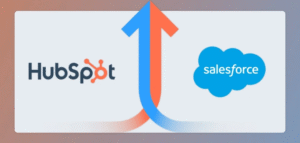In today’s dynamic business environment, seamless collaboration between marketing and sales teams is crucial. Disconnected systems can lead to fragmented customer experiences, missed opportunities, and inefficiencies. Integrating Salesforce and HubSpot offers a pathway to unify these functions, providing a comprehensive view of customer interactions and streamlining processes.
Understanding the Integration Landscape
Salesforce, a leading CRM platform, and HubSpot, renowned for its marketing automation capabilities, each offer robust features. However, when operating in silos, they can hinder the flow of information. Integration ensures that data flows bidirectionally, enabling:
- Unified Customer Profiles: Consolidating data from both platforms to create a single source of truth.
- Enhanced Lead Management: Streamlining the lead nurturing process by aligning marketing efforts with sales follow-ups.
- Improved Reporting: Combining metrics for a holistic view of customer engagement and sales performance.

Common Challenges in Integration
While the benefits are clear, integrating Salesforce and HubSpot is not without challenges:
- Data Mapping Discrepancies: Differences in data structures can lead to synchronization issues.
- Duplicate Records: Without proper deduplication strategies, integrated systems may create redundant entries.
- Workflow Conflicts: Pre-existing automation in both platforms can interfere if not harmonized.
- User Adoption: Teams may resist changes to their established workflows, necessitating change management strategies.
Oktana's Approach to Seamless Integration
At Oktana, we specialize in crafting tailored integration solutions that address these challenges head-on. Our approach includes:
- Comprehensive Assessment: Evaluating existing systems, workflows, and business objectives to design a customized integration plan.
- Robust Data Mapping: Ensuring fields align correctly between platforms to maintain data integrity.
- Automation Harmonization: Aligning workflows to prevent conflicts and enhance efficiency.
- User Training and Support: Facilitating smooth transitions with comprehensive training and ongoing support.
Real-World Impact: A Success Story
Consider a mid-sized tech company struggling with disjointed marketing campaigns and sales processes. By integrating Salesforce and HubSpot:
- Lead Response Time Decreased by 30%: Automated lead assignments ensured prompt follow-ups.
- Campaign ROI Increased by 25%: Unified data allowed for more targeted and effective marketing efforts.
- Sales Cycle Shortened by 20%: Improved visibility into customer interactions enabled quicker decision-making.
Best Practices for Successful Integration
To maximize the benefits of integrating Salesforce and HubSpot:
- Define Clear Objectives: Establish what you aim to achieve with the integration.
- Maintain Data Hygiene: Regularly clean and update data to prevent inaccuracies.
- Monitor Performance: Use analytics to assess the effectiveness of the integration and make necessary adjustments.
- Foster Collaboration: Encourage open communication between marketing and sales teams to ensure alignment.
Integrating Salesforce and HubSpot is more than a technical endeavor; it’s a strategic move towards unifying your business processes and enhancing customer experiences. At Oktana, we are committed to guiding you through this transformation with expertise and personalized solutions.
Ready to bridge the gap between your marketing and sales teams? Contact us today to explore how we can tailor an integration strategy that aligns with your business goals.



